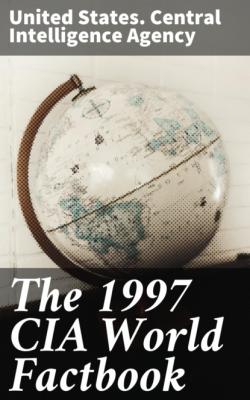The 1997 CIA World Factbook. United States. Central Intelligence Agency
Чтение книги онлайн.
Читать онлайн книгу The 1997 CIA World Factbook - United States. Central Intelligence Agency страница 12
 organization participation: AsDB, CP, ECO, ESCAP, FAO,
organization participation: AsDB, CP, ECO, ESCAP, FAO,G-77, IAEA, IBRD, ICAO, ICRM, IDA, IDB, IFAD, IFC, IFRCS, ILO, IMF,
Intelsat, IOC, IOM (observer), ITU, NAM, OIC, UN, UNCTAD, UNESCO,
UNIDO, UPU, WFTU, WHO, WMO, WToO
Diplomatic representation in the US: chief of mission : Ambassador (vacant); Charge d'Affaires Yar Mohammed MOHABBAT chancery: 2341 Wyoming Avenue NW, Washington, DC 20008 telephone: [1] (202) 234–3770, 3771 FAX: [1] (202) 328–3516 consulate(s) general : New York consulate(s): Washington, DC
Diplomatic representation from the US: the US embassy in Kabul has been closed since January 1989 due to security concerns
Flag description: three equal horizontal bands of green (top), white, and black with a gold emblem centered on the three bands; the emblem features a temple-like structure with Islamic inscriptions above and below, encircled by a wreath on the left and right and by a bolder Islamic inscription above, all of which are encircled by two crossed scimitars
Economy
Economy - overview: Afghanistan is an extremely poor, landlocked country, highly dependent on farming and livestock raising (sheep and goats). Economic considerations have played second fiddle to political and military upheavals during more than 17 years of war, including the nearly 10-year Soviet military occupation (which ended 15 February 1989). During the war one-third of the population fled the country, with Pakistan and Iran sheltering a combined peak of more than 6 million refugees. Now, only 750,000 registered Afghan refugees remain in Pakistan and about 1.2 million in Iran. Another 1 million have probably moved into and around urban areas within Afghanistan. Gross domestic product has fallen substantially over the past 17 years because of the loss of labor and capital and the disruption of trade and transport. Millions of people continue to suffer from insufficient food, clothing, housing, and medical care. Inflation remains a serious problem throughout the country, with one estimate putting the rate at 240% in Kabul in 1996. Numerical data are likely to be either unavailable or unreliable.
GDP: purchasing power parity - $18.1 billion (1996 est.)
GDP - real growth rate: NA%
GDP - per capita: purchasing power parity - $800 (1996 est.)
GDP - composition by sector: agriculture: 56% industry: 15% services: 29%
Inflation rate - consumer price index: 240% (1996 est.)
Labor force: total: 7.1 million by occupation: agriculture and animal husbandry 67.8%, industry 10.2%, construction 6.3%, commerce 5.0%, services and other 10.7% (1980 est.)
Unemployment rate: 8% (1995 est.)
Budget: revenues: $NA expenditures: $NA, including capital expenditures of $NA
Industries: small-scale production of textiles, soap, furniture, shoes, fertilizer, and cement; handwoven carpets; natural gas, oil, coal, copper
Electricity - capacity: 371,000 kW (1993)
Electricity - production: 670 million kWh (1994)
Electricity - consumption per capita: 35 kWh (1995 est.)
Agriculture - products: wheat, fruits, nuts, karakul pelts; wool, mutton
Exports: total value: $80 million (1996 est.) commodities: fruits and nuts, handwoven carpets, wool, cotton, hides and pelts, precious and semi-precious gems partners : FSU, Pakistan, Iran, Germany, India, UK, Belgium, Luxembourg, Czechoslovakia
Imports: total value : $150 million (1996 est.) commodities: food and petroleum products; most consumer goods partners: FSU, Pakistan, Iran, Japan, Singapore, India, South Korea, Germany
Debt - external: $2.3 billion (March 1991 est.)
Economic aid: recipient: ODA; about $56 million in UN aid plus additional bilateral aid and aid in kind (1996) note: US provided $450 million in bilateral assistance (1985–93); US continues to contribute to multilateral assistance through the UN programs of food aid, immunization, land mine removal, and a wide range of aid to refugees and displaced persons
Currency: 1 afghani (AF) = 100 puls
Exchange rates: afghanis (Af) per US$1 - 17,000 (December 1996), 7,000 (January 1995), 1,900 (January 1994), 1,019 (March 1993), 850 (1991); note - these rates reflect the free market exchange rates rather than the official exchange rate, which is a fixed rate of 50.600 afghanis to the dollar
Fiscal year: 21 March - 20 March
@Afghanistan:Communications
Telephones: 31,200 (1983 est.)
Telephone system: domestic : very limited telephone and telegraph service international: satellite earth stations - 1 Intelsat (Indian Ocean) linked only to Iran and 1 Intersputnik (Atlantic Ocean Region)
Radio broadcast stations: AM 6, FM 0, shortwave 2
Radios: 1.8 million (1996 est.); note - about 60% of families own a radio
Television broadcast stations: NA note: one television station run by Jumbesh faction provides intermittent service
Televisions: 100,000 (1993 est.)
@Afghanistan:Transportation
Railways: total: 24.6 km broad gauge: 9.6 km 1.524-m gauge from Gushgy (Turkmenistan) to Towraghondi; 15 km 1,524-m gauge from Termiz (Uzbekistan) to Kheyrabad transshipment point on south bank of Amu Darya
Highways: total: 21,000 km paved: 2,793 km unpaved: 18,207 km (1995 est.)
Waterways: 1,200 km; chiefly Amu Darya, which handles vessels up to about 500 DWT
Pipelines: petroleum products - Uzbekistan to Bagram and Turkmenistan to Shindand; natural gas 180 km
Ports and harbors: Kheyrabad, Shir Khan
Airports: 33 (1996 est.)
Airports - with paved runways: total: 16 over 3,047 m: 3 2,438 to 3,047 m: 4 1,524 to 2,437 m : 2 under 914 m: 7 (1996 est.)
Airports - with unpaved runways: total: 17 2,438 to 3,047 m: 3 1,524 to 2,437 m: 12 914 to 1,523 m: 2 (1996 est.)
Heliports: 3 (1996 est.)
Military
Military branches: NA; note - the military does not exist on a national basis; some elements of the former Army, Air and Air Defense Forces, National Guard, Border Guard Forces, National Police Force (Sarandoi), and tribal militias still exist but are factionalized among the various groups
Military manpower - military age: 22 years of age
Military manpower - availability: males age 15–49 : 5,813,298 (1997 est.)
Military manpower - fit for military service: males : 3,118,004 (1997 est.)
Military manpower - reaching military age annually: males: 231,250 (1997 est.)
Military